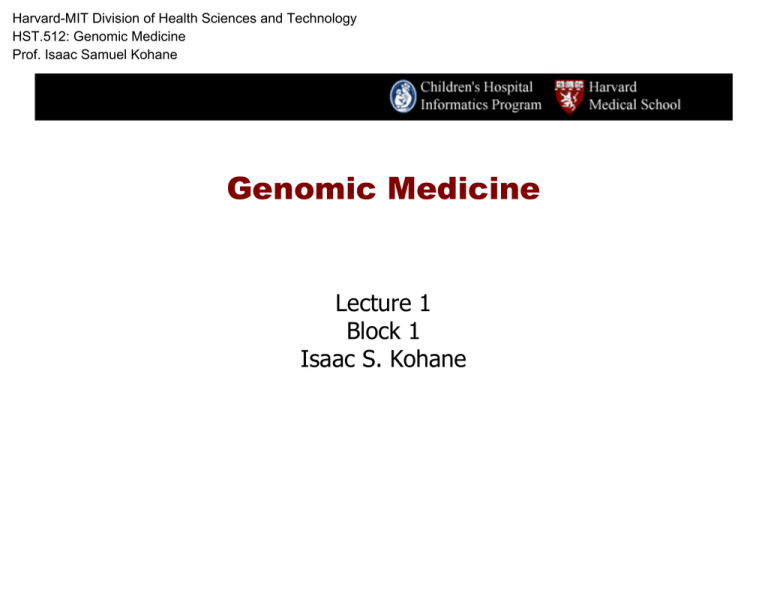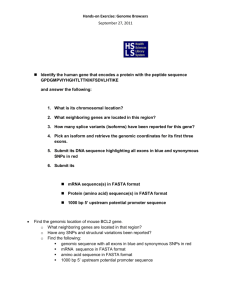Harvard-MIT Division of Health Sciences and Technology HST.512: Genomic Medicine
advertisement

Harvard-MIT Division of Health Sciences and Technology HST.512: Genomic Medicine Prof. Isaac Samuel Kohane Genomic Medicine Lecture 1 Block 1 Isaac S. Kohane Overview The future is now Genomic vs genetic Heredity Resequencing of the diagnostic process Accelerating consumer activation Overview The future is now Genomic vs genetic Heredity Resequencing of the diagnostic process Accelerating consumer activation The Long Path from Genotype to Function DNA Transcription Translation Structural Biology Nathan Baker UCSD Sequencing and genotyping Transcriptional Profiling Proteomics Magnitude of the Task Magnitude of the Task Madonna Complex Some say MadonnaMusic > MadonnaPerson 4.7 GB vs (3 x 109) x 2 (bits/base) / 8 (bits/byte) = 0.75GB Is Madonna, her DNA sequence? No, and her current state is captured by.. � Alternative splicing (x 3/gene) � Post-translational modification (x 100 -1000) � Location of gene product ( x 1012) She’s a little more complicated than her music (are you surprised?) RNA/DNA expression detection chips Tissue or Tissue under influence RNA cDNA copy Tagged with fluor Microarray of genes aka gene chips cDNA spotted on glass slide or oligonucleotides built on slide Please refer to following papers: Schena M, et al. Proc Natl Acad Sci USA; 93: 10614 (1996). Entire issue. Nature Genetics, 21: supplement (Jan 1999). The Promise: The New Diagnostics Please see Nature. 2000 Feb 3;403(6769):503-11. Distinct types of diffuse large B-cell lymphoma identified by gene expression profiling. Alizadeh AA, et al. Retreading the cancer chemotherapeutic protocol Cancer and Leukemia Group B (CALGB) CALGB has grown into a national network of 29 university medical centers, over 185 community hospitals and more than almost 3000 physicians who collaborate in clinical research studies aimed at reducing the morbidity and mortality from cancer Dozens of new protocols (breast cancer, prostate cancer, renal cancer) that use genome-wide � Which genes best predict survival? � Which adjuvant improves surgical outcome the best? � Can we find expression measure proxies for Stage, Grade and Cell Type New Taxonomy of Human Disease Clinicians may have moved on from calling ‘fever’ a disease, but they still rely on phenotypic criteria to define most diseases, Yet these may obscure the underlying mechanisms and often mask significant heterogeneity. Thomas Lewis pointed out in 1944, diagnosis of most human disease provides only “insecure and temporary conceptions” Of the main common diseases, only the infectious diseases have a truly mechanism-based nomenclature. Changes in Use of “Every day” Medications Please see Proc Natl Acad Sci U S A. 2000 Sep 12;97(19):10613-8. A common polymorphism associated with antibiotic-induced cardiac arrhythmia. Sesti F, et al. Growth in Our Knowledge of Variants Polymorphism Publications 8000 7000 6000 5000 4000 3000 2000 1000 0 1980 1985 1990 1995 Year (1981-2001) 2000 2005 Growth in monogenic disease Pace of disease gene discovery (1981 to 2000). The number of disease genes discovered so far is 1112. This number does not include at least 94 disease-related genes identified as translocation gene-fusion partners in neoplastic disorders. Numbers in parentheses indicate disease-related genes that are polymorphisms ("susceptibility genes"). (From McKusick) One-pass genotyping Please see Figure 1 of Science. 2001 Nov 23;294(5547):1719-23. Blocks of limited haplotype diversity revealed by high-resolution scanning of human chromosome 21 Patil N, et al. •Chromosome 21: 21,676,868 bases (67%) of unique sequence were assayed for variation with high-density oligonucleotide arrays •Synthesized 3.4 × 109 oligonucleotides on 160 wafers to scan 20 independent copies of human chromosome 21 for DNA sequence variation. Bioinformatics: 1998 Ambitions Find the functions + 30,000 genes using of all � DNA sequence � Genetics maps � Physical maps � Polymorphisms � Structure information � Existing biomedical literature � Gene transcription patterns � Protein translation/activity With growing databases containing data, this becomes a problem in the realm of bioinformatics Please see Figure 1 of Nat Genet. 1998 Sep 20(1):19-23. Data management and analysis for gene expression arrays. Ermolaeva O, et al. Madonna Complex Some say MadonnaMusic > MadonnaPerson 4.7 GB vs (3 x 109) x 2 (bits/base) / 8 (bits/byte) = 0.75GB Is Madonna, her DNA sequence? No, and her current state is captured by.. � Alternative splicing (x 3/gene) � Post-translational modification (x 100 -1000) � Location of gene product ( x 1012) She’s a little more complicated than her music (are you surprised?) Overview The future is now Genomic vs genetic Heredity Resequencing of the diagnostic process Accelerating consumer activation An engineer, a physicist, a mathematician, a computer scientist, and a statistician are on a train heading north, and had just crossed the border into Scotland. They look out the window and see a black sheep for the first time. The engineer exclaims, “Look! Scottish sheep are black!” The physicist yells, “No, no. Some Scottish sheep are black.” The mathematician looks irritated and says, “There is at least one field, containing at least one sheep, of which at least one side is black.” The computer scientist says, “Oh, no, a special case!” Finally, the statistician says, “It is not statistically significant!” Genomic vs genetic Genetic Medicine Genomic Medicine Low frequency of ~1000 of usually high penetrance genes The genetic risk for common diseases will often be due to disease-producing alleles with relatively high frequencies (>1%). All genes may be disease causing. 1000’s of relatively uncommon diseases (1/300 f or most common) Common disorders due to the interactions of multiple genes and environmental factors Mostly assessed indirectly & focused Direct experimental access to the entire geno On single genes me Genetic vs Genomic Genetic Structural genomics Genomics Map-based gene discovery Monogenic disorders Specific DNA diagnosis Analysis of one gene Gene action Etiology (specific mutation) One species Genomic Functional genomics Proteomics Sequence-based gene discovery Multifactorial disorders Monitoring of susceptibility Analysis of multiple genes in gene families, pathways, or systems Gene regulation Pathogenesis (mechanism) Several species Adapted from McKusick and Peltonen Comprehensive Bioinformatics Approach: All Data Are Grist Reductionist methods that take into account data-type particularities P1 P2 P3 P4 Interactions between all the “grist” is relevant to the health state Traditional Genetics GX Linkage & GP Linkage Disequilibrium Co be rre Mode of Inheritance GP2 la Te tion ste to d Cultural Factors Ph Individual Environment GP3-GPN Polygenic Background Common Environment Determining the aforementioned interaction is hard and runs counter to traditional biostatistical techniques Variables (10’s-100’s) Cases (10’s-100’s) Cases (1000’s-1,000,000’s) Variables (10,000 - 100,000) High-dimensionality systems with insufficient data are undeterdetermined Not tractable by standard biostatistical techniques The New Pharmacology RNA expression in NCI 60 cell lines was determined using Affymetrix HU6000 arrays � 5,223 known genes � 1,193 expressed sequence tags The RNA expression data set and Anti-cancer susceptibility data set were merged, using the 60 cell lines the two tables had in common 6,000 genes RNA Expression 5,000 anti-cancer agents Common 60 Cell Lines Drug Susceptibility Genes and Anti-Cancer Agents Threshold r^2 was 0.8 202 networks 834 features out of 11,692 (7.1%) 1,222 links out of 68,345,586 (.0018%) Only one link between a gene and anti-cancer agent Genes and Anti-Cancer Agents Elevated levels of J02923 (lymphocyte cytosolic protein-1, LCP1, L-plastin, pp65) is associated with increased sensitivity to 624044 Agent 624044 is 4-Thiazolidinecarboxylic acid, 3-[[6-[2-oxo-2(phenylthio)ethyl]-3-cyclohexen-1-yl]acetyl]-2 thioxo-, methyl ester, [1R[1a(R*),6a]]- (9CI)) LCP1 is an actin-binding protein involved in leukocyte adhesion A role for LCP1 in tumorogenicity has been previously postulated Low level expression of LCP1 is thought to occur in most human cancer cell lines Other thiazolidine carboxylic acid derivatives are known to inhibit tumor cell growth Butte et al. PNAS 2000 Overview The future is now Genomic vs genetic Heredity Resequencing of the diagnostic process Accelerating consumer activation Heritability: the way a population geneticist would think of it. Heritability in the Broad Sense (H) � This measure of heritability includes all genetic influences on the phenotype, whether due to additive, dominance, or interactive effects. � H2 = VG / VP, where VG = VA + VD + VI Obesity Don’t some people just eat and not get fat? Isn’t it in their genes? Heritability All those of you with… leave the room OBESITY • National Center for Health Statistics: Over 50% of US adults have BMI > 25 About 22% of US adults have BMI > 30 • National Health & Nutrition Examination Survey III: 20% of U.S. children overweight • Behavioral Risk Factor Surveillance System (CDC) Prevalence of obesity up by 50% from 1991 - 1998 Prevalence of Obesity Compared to Percent Calories from Fat Among US Adults Percent 45 40 Calories from Fat 35 30 25 Prevalence of Obesity 20 1960 1970 1980 1990 Year After: Allred JB. JADA 95:417, 1995 Heritability is defined with respect to environment How do we define environment? � Diet � Daily habits � Environmental insults � Medical care � …. Genotype does not capture the individual patient state We need to capture and quantify the environmental influences. We need to capture the effect of the genotype and environmental effects on the phenotype. These two comprise � History � Physical � Laboratory Studies � Imaging The New Medicine A More Expansive Reductionism More to the state description than genome Given necessity to capture both environment, genomic state and their interaction. � Only then we can elucidate VE and VG and VGE � Clinical informatics and genomic/bioinformatics � Required for effective new therapies � Required for deeper understanding of mechanism Requires capturing the aforementioned interactions � The less we capture, the more undetermined the system Overview The future is now Genomic vs genetic Heredity Resequencing of the diagnostic process Accelerating consumer activation Pediatric Growth Monitoring •Data: ­ heights, weights ­ family history ­ bone ages ­ pubertal data, stage s •Disorders show characteristic patterns on growth chart. Work-up of Short Stature with Poor Growth T4, IGF-1, ESR, CBC, anti-gliaden Ab… Insulin Tolerance Test/Glucagon GH Test � 6 hours in the hospital � IV insulin with symptomatic hypoglycemia � Glucagon with nausea � $1000-$2000 Interpretation remains controversial � Significant false positive rate: Why? � Significant false negative rate: Why? 1. What is the most common chromosomal cause of short stature? 2. 2.5% of idiopathic short stature children (including males) have SHOX mutations 3. Mutants are not growth hormone deficient but… They respond to Growth Hormone therapy! 7325 articles on screening and diagnosis with PSA From SMA-12 to SMA-30000 Qi= ( < Tsel(1) ,Rsel(1),k sel(1) >, ..., < Tsel(i) ,Rsel(i),k sel(i) > ) PHj|QiPH j PH j |Q = n i ∑P P Qi|Hk Hk k=1 Peforming i of m possible tests, � we can choose mPi (= m! / ( m-i)!) test sequences If every test has r possible results, then there will be rimPi possible test histories after i tests sum over test histories of every length and multiply by the number of hypotheses, n n=10 hypotheses, m=5 binary tests ( r=2) � the analysis requires 63,300 conditional probabilities Re-engineering the knowledge-base Cochrane Collabor ative 1992 Founded to gather, edit evidence for medical practice; 50 Collaborative Review Groups 7000 Collaborator s, internationally Overview The future is now Genomic vs genetic Heredity Resequencing of the diagnostic process Accelerating consumer activation The privacy challenge is now Course Administrivia Both MIT and Harvard Spring Breaks observed Problem sets: � 2 total Final project (up to 2 persons per project) � Project selected by March 15th Course Overview Biology Refresher Genomic Measurement Techniques Functional Genomics and Microarrays Limits of the Technologies: Noise Information Science at the Center of Genomic Medicine Informational Resources Modeling, Reverse Engineering The Importance of Data Representation Course Review Machine Learning Approach Association with Markers Case Hx: Complex Trait Analysis Complex Traits: What to believe Microarray Disease Classification I Direct Prediction Outcome/Mortality Histopathology Case History Microarray Disease Classification II Practical Genomic Medicine: Today's Practice Individualized Pharmacology Course Review Finding new drugs Ethical and Social Considerations Commercial and Regulatory Barriers Newborn Testing The New Microbiology






![Instructions for BLAST [alublast]](http://s3.studylib.net/store/data/007906582_2-a3f8cf4aeaa62a4a55316a3a3e74e798-300x300.png)